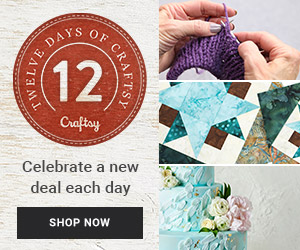I've been working on Painted Pictorial Quilts with Annette Kennedy for awhile. Let me clarify that: I've been watching Painted Pictorial Quilts with Annette Kennedy for awhile. I've owned this class almost since I first joined Craftsy a couple of years ago. I'd started watching it back then but decided that I needed to have the time and space to commit to the project, so I set it aside. This time around, when I pulled it back into rotation again, I decided not to do the class project but, instead, to watch the lessons and apply techniques to my own projects.
Therefore, there are no pretty pictures of projects-in-progress on this review. That's not to say that the two class projects aren't really wonderful projects--I seriously debated one of them because it's of a calla lily that is gorgeous (and calla lilies are a personal fave). But ultimately, I determined that I didn't need one more project on my list that would distract me from other things already in my head, so I focused instead on watching the lessons and absorbing her techniques.
I had to debate how I was going to approach this review a little bit--I'm not able to be as completely enthusiastic about this class as I have been about most others, but the primary cause of my lesser-enthusiasm has to do with how Craftsy approached the class, not anything to do with the subject or teacher. So let's get that out of the way first...
You can tell this is a very early Craftsy class. They've definitely fine-tuned their methods over the years. To whit: There are some difficult patches in the earlier lessons where the camera was zoomed so close in on Annette's hands doing the painting that it was actually difficult to follow. She encourages you to move the fabric around so you can always be painting from a comfortable angle--great tip, but with a close-in-zoom it actually triggered my motion sickness a bit as the project was constantly flipping back and forth and often moving off-camera, so the camera had to zoom out quickly and then zoom back in to catch up with where she was positioned again. There were several periods in which I just had to close my eyes and wait until things settled down. You don't see that in more recent classes--they've gotten much more professional and polished in their video.
The other thing that Craftsy does much better now is fades/cuts during longer processes. In this class, you are watching every single stroke she makes with the paint brush. Annette does a great job "vamping," or talking while she's painting and occasionally giving additional tips or information, but this class could have been a whole lot tighter without losing any of the content if they'd shown her doing a particular technique for a couple of minutes, then either sped up or cut back in after she'd finished that section. There are a ton of lessons and they're all pretty long--I had to keep sort of gearing myself up to take on another lesson, and I watched most of them at double speed. I think the class could easily have been cut by about a third and we wouldn't have lost any value whatsoever.
It struck me that there are times in this class you are quite literally watching paint dry.
Now, those are my only knocks on this class and, again, it has everything to do with Craftsy getting better at what it does than anything having to do with the content or teacher. So let me get back to the more positive aspects.
Annette Kennedy is an excellent teacher. Earlier lessons talk about how to design a painted project, as well as all the supplies you'll need. She spends one lesson each on how to assemble the two class projects before starting in on the painting, so you pick up some good information about creating applique from photos and how to turn photos/drawings into pattern pieces, and so forth. She explains why different types of strokes are most appropriate for different parts of the painting; she spends a lot of time talking about blending colors and getting different values of a single color. There's a whole lesson devoted to color blending and another devoted to depth and dimension. Even with all the work I've done on color over the last few years, I still picked up some very useful information from these lessons as things work differently in paint than in fabric or other media.
The class projects really are very cool. If you're looking for some guided projects to help you really have these techniques sink in, I would highly recommend doing the class projects. The class materials include all the patterns and painting guides you need to follow her techniques. As I was watching her paint (and watching, and watching), I did mentally design about five different painted quilts based on what she did.
Even though I didn't do either of the projects, I did pick up a couple of additional supplies after I had the opportunity to watch how she used them. I've only just recently started playing with fabric paints and hadn't understood what a floating medium was for until I watched this class; I also realized that mixing colors with the brush was far less useful than using a palette knife as she does--so I now own a few inexpensive plastic palette knives, thanks to Joanns. This whole fabric painting thing will go much more smoothly in the future, I think, thanks to Annette Kennedy.
I'm very much looking forward to being able to put Annette's techniques into use in future projects. At the moment, I'm just debating whether my next journal quilt will involve textile paints (and her techniques) or colored pencils (and Lola Jenkins' techniques). Or it may, instead, be straight embroidery based on the crewel wool embroidery class I'm about to finish. So many options, so little time...
The Basics
- 15 lessons, ranging from 12 1/2 minutes to 1 hour and 8 minutes. Several lessons are around an hour; several others are between 30-45 minutes. Only a small handful are about 15 minutes. You really get a huge volume of material, here.
- The class materials (9 documents) are several pages long, mostly because of the patterns. There are some helpful reference pages among them.
- The first lesson spends time on an introduction of Annette Kennedy and of the Craftsy platform, and then she talks a bit about the two class projects.
- Lessons 2-4 give a nice foundation to what's to come: how to create visual depth, turning photos into designs (you don't need to know how to draw, BTW), and various brush strokes.
- Lessons 5-7 focus on the calla lily project, which gives you a lot of experience in blending, shading, and creating dimension.
- Lessons 8 and 9 are on color and depth and dimension, including selecting color schemes, how to achieve different color effects with paint, how to create distance and scale, and so forth.
- Lessons 10-13 focus on the canyon project; this gives you the opportunity to take what you've learned on the calla lily even further.
- Lesson 14 is on quilting and finishing, with useful tips about how to emphasize the focus of your project through quilting, and a little bit about painting after quilting as well.
- Lesson 15 is a "bonus" lesson that describes how to do a sun print collage with fabric paints. If you've never seen how to do this, the lesson will introduce you to a very cool way to create fabric.
I have sort of a one-thumb-up, one-thumb in the middle on Painted Pictorial Quilts with Annette Kennedy. I want to emphasize, though, that the thumb in the middle would be very much up if Craftsy had done this class using the parameters it has now worked it's way into: in other words, if it had been a bit tightened up and had better camera angles in the earlier lessons. If I only look at content and teacher, it's two thumbs up.

























